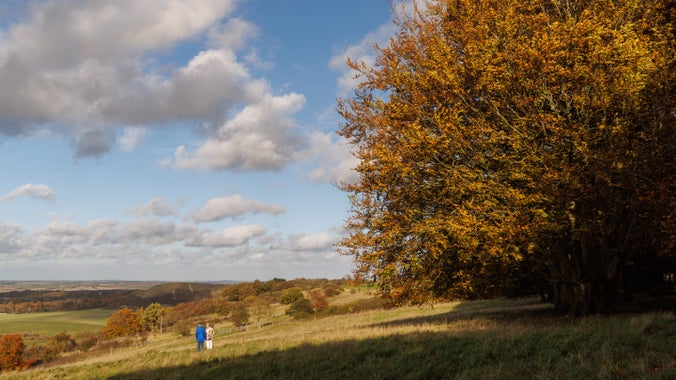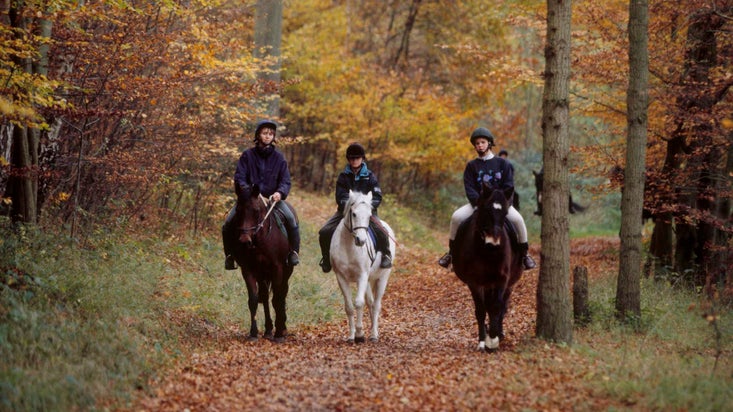
Become a member
Join today and help protect nature, beauty and history – for everyone, for ever. Enjoy access to more than 500 places with National Trust membership.
Ancient trees, rolling chalk downlands and lush meadows in an area of outstanding natural beauty
Moneybury Hill, Ringshall, Near Berkhamsted, Hertfordshire, HP4 1LT

| Asset | Opening time |
|---|---|
| Estate | Dawn - Dusk |
| Café | 09:00 - 16:00 |
| Shop | 10:00 - 16:00 |
| Visitor centre | 10:00 - 16:00 |
Second hand book shop inside the visitor centre.
Monument Café serving hot and cold drinks, hot food, sandwiches, light bites and cakes. Outdoor seating only.
Parking on Monument drive.
Well behaved dogs are welcome across Ashridge Estate, dogs on leads inside visitor centre and shop.
Peat-free plants, plus pots and garden ornaments.
Garden, books, gifts and local produce in our shop.
To the left of the visitor centre.
Accessible toilets and routes. Blue Badge parking. Mobility vehicles available. Visitor centre and shop accessible.
Path around the meadow is suitable for wheelchairs
Acessible toilet
Blue badge parking spaces behind our visitor centre and the café.
Induction loops are available at the shop.
Café situated to the right of the visitor centre.
Shop situated to the right of visitor centre.
April-October. PMV's available to hire as a 4 seater, 2 seater or a single, please call 01442 851227 to book.
Accessible benches and chairs available outside.
Main car park entrance - what3words: ///blitz.shudders.palettes
Herts Lynx service can also be booked from Berkhamsted and Tring Stations to Ashridge – Bridgewater Monument.
This is operational 7am-7pm Monday to Friday and 10am-4pm on Weekends and Bank Holidays.
Journeys follow no set timetable or route, and can instead be booked using the HertsLynx app, website or by calling the team on 01992 555 513.
The 378 bus is also available with buses stopping in Aldbury village (a ½ mile uphill walk) and in Tring (a 1¾ mile walk).
Plan your route to Ashridge Estate using the CycleStreets journey planner via the by bicycle link below (This journey planner uses OpenStreetMap data which is generally excellent by accuracy cannot be guaranteed. If you come to a footpath or other cycle-prohibited track, please don’t ride on it).
Moneybury Hill, Ringshall, Near Berkhamsted, Hertfordshire, HP4 1LT
We are looking at making changes to the infrastructure across the estate to help manage the careful balance of increased visitor numbers with the impact on nature. Read about the 'Protecting Our Roots' project and find out more about our vision for the future of Ashridge Estate.
The woodlands at Ashridge cover nearly 1000 hectares, the largest in-hand woodland within the care of the National Trust. The variety of woodland at Ashridge means a wide range of habitats are found across the estate including ancient woodlands, wooded commons and plantations.

We believe Ashridge Estate should be open and accessible for all. Read on to discover how best you can visit to experience and enjoy nature, beauty and history.

Ashridge is a two pawprint rated place with over 80 miles of pathways. Find out more here.

For information on our estate walks and where to go at Ashridge, please see our estate map.
Situated in an area of outstanding natural beauty in the Chiltern Hills with beech and oak woodlands, commons and chalk downlands.
Opens in Spring. 172-step granite column with a York stone base, offering bird's-eye views of the estate. Open weekends during April to October, weather permitting. Charge for non-National Trust members.
Rolling chalk grasslands rich with wild flowers. Designated a Site of Special Scientific Interest (SSSI) for its special wildlife.
Outdoor café with hot and cold food and drinks. No indoor seating is available.
Shop selling gifts, local produce and home accessories. Plant shop and second-hand bookshop located at the visitor centre.
Visitor information about routes and activities. Home to the gift and plant shop, and second-hand bookshop.
A rare and striking example of an early form of post mill, one of the oldest in Britain. Explore the workings of the windmill, including the massive post upon which the mill turns, while also taking in spectacular views of the surrounding Chilterns countryside. Open Fridays and Bank Holiday weekends May to September.
Ashridge has over 80 miles of pathways 5,000 acres of woodland, from the windmill to Bridgewater Monument and panoramic views of the estate, there’s lots to explore at Ashridge Estate.

We are looking at making changes to the infrastructure across the estate to help manage the careful balance of increased visitor numbers with the impact on nature. Read about the 'Protecting Our Roots' project and find out more about our vision for the future of Ashridge Estate.
Ashridge has over 80 miles of pathways to explore, on foot, on bike and on horseback.

The Bridgewater Monument to Pitstone Windmill circular walk combines two of the best reasons to visit the Ashridge Estate.

Discover how many butterflies you can spot on this easy circular route on the Ivinghoe Hills at Ashridge Estate.

Discover the Golden Valley, a hidden gem of the Ashridge Estate, on this 4.3-mile walk. Designed by the famous 'Capability' Brown this masterpiece ranks among his finest works.

Enjoy a gentle walk along the popular Duncombe Terrace, taking in the historic Bridgewater Monument, as well as Ashridge Woods with its ancient trees and varied wildlife.

Follow the green arrows to discover the outstanding features of Ashridge Estate, including Ivinghoe Beacon, Incombe Hole, ancient woodlands and dramatic scenery.

Follow the green arrows to discover the outstanding features of Ashridge Estate, including the Golden Valley, ancient woodlands and dramatic scenery.

Discover the shop at Ashridge Estate. It’s through your purchases that we’re able to continue looking after Ashridge Estate for everyone, for ever.

Sorry, there are no upcoming events at this place
Ashridge Estate is a 2,000 hectare (5,000 acres) area of the Chiltern Hills AONB with beech and oak woodlands, commons and chalk downlands. These very different landscapes each support a rich variety of wildlife, including carpets of bluebells in spring, rare butterflies in summer and fallow deer that rut in autumn.
In recent years the population surrounding Ashridge Estate has increased significantly and we have seen a dramatic increase in the number of visitors to the estate, particularly around Monument Drive and the visitor centre area. This increase in footfall is beginning to have a significant impact on the landscape and the special habitats in our care.
We are planning to make changes to the infrastructure across the estate so we can continue to welcome visitors in a way that allows nature and wildlife to thrive. Read more about the Protecting Our Roots project.
A working estate
The National Trust took over the Ashridge Estate in 1926 and our Countryside team still manage the landscape as a working estate, continuing 3,000 years of tradition. We use livestock to help look after the diverse habitats on the downlands and our foresters fell timber to ensure the health of the woodland. Keep an eye out for both two and four legged conservation team members during your visit, our human ones will be happy to answer questions on our work.
Ashridge's long history begins with Iron Age farms, Roman settlements and a royal park, to Lancelot ‘Capability’ Brown creating the Golden Valley.

The woodlands at Ashridge cover nearly 1000 hectares, the largest in-hand woodland within the care of the National Trust. The variety of woodland at Ashridge means a wide range of habitats are found across the estate including ancient woodlands, wooded commons and plantations.

We are looking at making changes to the infrastructure across the estate to help manage the careful balance of increased visitor numbers with the impact on nature. Read about the 'Protecting Our Roots' project and find out more about our vision for the future of Ashridge Estate.
The Bridgewater Monument at the National Trust’s Ashridge Estate is to be steam cleaned for the first time in its history as part of major conservation work taking place this summer.
Ashridge Estate sees large areas of bluebells flowering each year which attracts large numbers of visitors. With the flowering window being short over April and May, this creates great pressure on the woodland and its flora during this period. Find out how you can help to look after the bluebells at Ashridge Estate

The fallow deer are an integral part of the landscape at Ashridge and a much-loved feature of this historic estate. Find out about their history here and how we manage them.

Discover the volunteering roles currently available at Ashridge Estate, and how you can apply and get involved today.


Join today and help protect nature, beauty and history – for everyone, for ever. Enjoy access to more than 500 places with National Trust membership.
By sharing your email address you’re agreeing to receive marketing emails from the National Trust and confirm you’re 18 years old or over. Please see our for more information on how we look after your personal data.